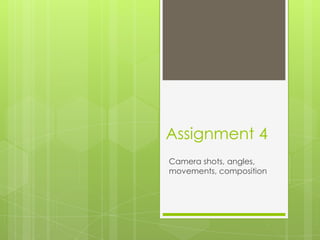
Assignment 4 section a , coursework
- 1. Assignment 4 Camera shots, angles, movements, composition
- 3. Establishing Shots Getting a shot from a distance. This is to reveal more information on the picture, this would show more detail
- 4. Wide shots A wide shot would be wide enough to see enough information in the picture. Its like panoramic, detail of the place where enough information would be seen. This would be used in wedding, to show the bride and groom to what’s around them.
- 5. Long shots To see the whole body/object/animal etc. This is used to see there body language, in a dinner table would show how everything is laid out
- 6. Mid/Medium shots Isa shot that would show their head and their torso, or their torso and legs This would show their facial expression, body language, and mostly used in dialogue
- 7. Close up shots Where the camera would focus on one object or hand This is to point out there emotions if its on their face. Or their plate, so the audience would know where to look at
- 8. Extreme close ups Its where the camera would show the details of an object/flower etc This is normally used in nature, when taking a picture of a flower, this would show the details of the petals or the insects on the petals.
- 9. Point of view (POV) Its where the camera would replace someone, the camera would be placed where the eyes would be and move like a human being. This is normally used when someone faints, and how the camera would shake as if the camera is the person
- 10. Over the shoulder When the camera is placed back of the characters shoulder. This is used especially when we are meant to focus on one character for example when talking, and would see there facial expression.
- 11. Two shots When two human beings/object/animal is in one shot This is when for example 2 human beings interact for example talking or having dinner together. Best friends shopping etc.
- 12. Ariel shots A shot taken from a helicopter would see everything. This is used to aware the audience where the location would be
- 13. Over head shot Its when the camera is above the character. this is used to make the character seem smaller.
- 14. CAMERA ANGLES!
- 15. Low angle When the camera would be lower than the character/object etc. It would enhance their roles, make them more powerful and also make them look big.
- 16. High angle The camera would be higher than the character Makes the character look smaller, more vulnerable or weak etc.
- 17. Canted/oblique Makes the shot seem tilted or skewed. Its normally to confuse the audience.
- 18. CAMERA MOVEMENT!
- 19. Pan When the camera would pivot horizontally, left to right/right to left This is normally used to show more information. http://www.youtube.com/watch?v=Hh yXtWjN-uw&feature=g-upl
- 20. Tilt The camera would go low to high or high to low. This is also used to get more information http://www.youtube.com/watch?v=nZ OaMCThtH0&feature=g-upl
- 21. Track The camera would move side to side without pivoting This is used to follow a character or an object with smooth movements that’s either side to side, back to front or curved movements.
- 22. Zooming When the camera is still but zooms in to get closer to a character or an object This is to create intensity http://www.youtube.com/watch?v=4t q9gWUdrRs&feature=g-upl
- 23. Reverse zooming This is the same as zooming but comes out from the character/object back to normal. This is used to reveal more detail, might be the location or to show their body language. http://www.youtube.com/watch?v=Az xFO2zJL0M&feature=g-upl
- 24. Dolly When the camera would move in and out, backwards or forwards on a track and can move in different angles. (this isn’t track or zoom) http://www.youtube.com/watch?v=lXF Z7OlycAY&feature=g-upl
- 25. Crane When the camera is on the crane whilst the crane is moving This is used normally in action films for example racing.
- 26. Stedicam When the camera is stable on a human, so it doesn't shake, but moves smoothly while the person is moving. This is used when filming a football match
- 27. Vertigo A movement which is zooming and dolling at the same time. If it dolling in zoom out. If its dolling out zoom in. This is normally used in dramatic scenes.
- 28. COMPOSITION!
- 29. Balance The way that the image balances the shape, size. The way we place the objects in a frame to show balance
- 30. Symmetry To show order, and its the same on both sides. This is used to show normalness and organization
- 31. Asymmetric Itswhere they don’t look the same from both sides. This is used for to show disorder, chaos etc
- 32. Rule of thirds Ishere there’s a grid on the screen of the camera and it helps to make the image show spaced out instead of being in he centre This is used to promotes better tension, energy and interest in a composition.
- 33. Depth of field Itsthe difference between the nearest and farthest objects. A distance of what would be focussed. A the camera can only look at one object/character.
- 34. Shallow focus Emphasises and highlights one object/character and the rest is blurry. This is used to aware the audience where to look, directs us where we should look the most.
- 35. Deep focus Its the opposite of shallow focus, the entire image is in focus. And there's foreground (FG), middle ground (MG) and back ground (BG). (when there's a character in from of the camera (FG), the second person is the middle (MG) and the there's a third furthest away from the camera then the background(BG))
- 36. Focus pulls When one object is clear and behind that object is blurry or the other way round.